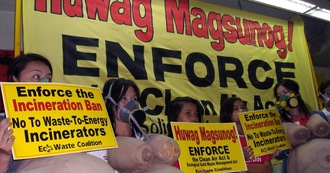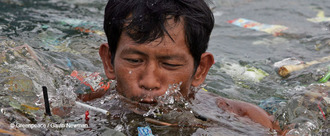-
Clear Seas and Skies AlbayAs the universal law of gravity states, what comes up must go down. Recently, the province of Albay has been growing into the trend of releasing sky lanterns and balloons in special events (such as the most recent one held last February 13, 2019 at Legazpi City Albay). Although the activity could look beautiful for a moment, the mess it leaves can last decades affecting us and the environment around us. Albay is home to hundreds of beautiful creatures and is also declared as a UNESCO biosphere reserve, joining a list of areas around the world that are prime examples of sustainable development and biodiversity, however with our current practices, we could lose this beautiful area to pollution. For more information on the harmful effects of the release of lanterns and balloons, check out (https://www.facebook.com/105848482838036/photos/?tab=album&album_id=1318238384932367) Help us convince our officials to ban the release of sky lanterns and balloons in Albay and save what we (and the other creatures living in Albay) call "home".81 of 100 SignaturesCreated by Titus Canete
-
STOP CEBU's La Vie in the Sky Skylanterns Release"I would like us all to make a serious commitment to respect and protect creation, to be attentive to every person, to counter the culture of waste and disposable, to promote a culture of solidarity and of encounter. Thank you." - Pope Francis. General Audience June 5th, 2013 "This same “use and throw away” logic generates so much waste, because of the disordered desire to consume more than what is really necessary." - Pope Francis (Laudato Si, 123) This activity is INTENTIONAL VIOLATION of Republic Act 9003 - mismanagement and improper segregation of waste. Likewise, of the fisheries code and wildlife act, among others. 1. What goes up must come down, and farmers in particular have become increasingly concerned that livestock might swallow a lantern's wire or bamboo frame, or, even worse, that fires might break out in hay barns. Elsewhere, coastguards say lanterns, which can travel for several kilometres and to an altitude of 1,000m before the candle burns out, are routinely mistaken for distress flares. A handful of east Asian countries, such as Vietnam, Malaysia and Thailand, have already introduced bans, particularly in the lead up to major festivals. (https://www.theguardian.com/environment/2010/feb/02/sky-lanterns-danger-farm-animals) 2. Countries like Argentina, Austria, Australia, Brazil, Chile, Colombia, Costa Rica, New Zealand, Spain, Germany, and parts of Canada and the USA have actually already banned the release of sky lanterns. (http://www.wheninmanila.com/why-we-should-not-release-balloons-skylanterns/). 3. However, the worst part of the fallout from the activity is the impact on local fauna. Reports of animals dying painfully, typically strangled by old lanterns' wires or suffocated by undecomposed paper, are frequent during this time of year. Some visitors are no doubt already aware of this, particularly following the high-profile death of an owl in the U.K. a few years ago. The bird was found suffocated and partly burnt inside the remains of a lantern... Humans are also at risk. The light emitted by lanterns sent en masse at night has been proven to be disruptive to aircraft pilots. As such, some countries like Malaysia have banned the use of sky lanterns in and around certain cities in order to prevent fatal accidents. (http://www.chinapost.com.tw/editorial/taiwan-issues/2017/02/10/491229/pingxis-sky.htm) 4. Though they are undoubtedly beautiful, even the biodegradable lanterns can be incredibly harmful to both the environment and wildlife. Sky lantern litter takes quite some time to decompose, and the wire frames have been known to strangle and maim wild animals and livestock. They also pose a significant fire hazard. Not only have they caused multiple wildfires, a sky lantern was also responsible for a massive fire at the Smethwick Recycling Plant in West Midlands, England. (http://earth911.com/living-well-being/events-entertainement/environmental-impact-traditions/) 5. With Save Philippine Seas, know more about the ills and harms of sky lantern releases here: https://www.facebook.com/pg/savephilippineseas/photos/?tab=album&album_id=13182383849323671,150 of 2,000 SignaturesCreated by Living Laudato Si' Philippines

-
No To Petron Depot in Pongol Balogo Pasacao Camarines SurBalogo Pasacao Camarines Sur is known as one of the key player of tourism in "the summer capital of camarines sur" Pasacao, knowing that this is a tourist area putting up an oil depot that covers 2.6hctrs of land and a massive port of 800meters that could handle both inter island and international vessels would not only stop the tourism but would also Destruct the marine life, Farmers life, and the crystal clear waters of these beaches.181 of 200 SignaturesCreated by Jeth Ablaneda
-
No to Coal-fired Power Plant in La Union, the Surfing Capital of the North!La Union is under threat: the construction of a 670-megawatt coal-fired power plant (CFPP) is expected to commence this year, in the historic town of Luna, which is known for its natural geophysical and cultural assets of high ecological, livelihood and touristic value. Within the 2 to 30 aerial-kilometer radius of the proposed coal-fired plant are the towns of Balaoan, known for its bountiful corn harvests and biodiverse coral gardens; of San Juan and Bacnotan, the main surfing areas; and of San Gabriel, home to Tangadan Falls (the most popular falls in Northwest Luzon) and Lon-oy Springs (a major water supply source of the City of San Fernando and suburbs). All of these will be degraded and eventually destroyed once the CFPP starts spewing toxic chemicals. Moreover, the water heated by the plant’s cooling system will blanch and damage supersensitive corals within the Darigayos Cove, known for its rich marine ecosystem (the source of livelihood of thousands of fisherfolks) and heritage structures along its white beach. We APPEAL to President Rodrigo Duterte, DENR Secretary Roy Cimatu, DOT Secretary Bernadette Romulo-Puyat, Sen. Cynthia Villar (Environment Committee), Sen. Sherwin Gatchalian (Energy Committee), DA Secretary Manny Pinol, Congressman Pablo Ortega, Congresswoman Sandra Eriguel, Governor Francisco Emmanuel Ortega III, Vice Gov. Aureo Nisce, Mayor Victor Marron and Vice Mayor Romeo Resureccion to: 1. Deny GLEDC’s application for an environmental compliance certificate (ECC) including other permits to construct and operate the CFPP. The proponents used deceit, bribery and strong-arm tactics to suppress opposition to their plan and did not fully comply with the required ECC processes as it only consulted residents in the five (5) barangays in and around the proposed 41-hectare site and excluded/ignored other towns and barangays within the plant’s immediate impact area as shown by the NO2 modelling exercise done by its own environmental consultants. Likewise, the Environmental Impact Assessment done by GLEDC’s consultants was also found to be technically deficient and misleading by other technical experts. 2. Pursue an alternative development agenda that is consistent with the Agri-Tourism Development Strategy of the Provincial Government of La Union being espoused by no less than Governor Pacoy Ortega. The proposed site and the nearby Darigayos Cove and Mt Kangisitan can instead be developed as an ecotourism zone linked with other touristic attractions of La Union. 3. Identify and develop renewable energy sources to augment the country’s power supply. As La Union has a very high photovoltaic potential, more solar farms similar to those in Batangas should be built as soon as possible.6,703 of 7,000 SignaturesCreated by Koalisyon Isalbar ti Pintas ti La Union (Coalition to Save the Beauty of La Union)

-
No to Coal in BoholAlarmed that there are sectors in the Provincial Government along with investors and power providers who are poised to endorse a backward idea of a coal-fired power plant in the island, we demand that our leaders to lead us in achieving Bohol’s Goals that include, among others, Environmental Protection and Management; and, Responsive, transparent and accountable governance. Drawing from our earlier manifesto, we echo the call, this time, taking a firm stand against whatever plans and machinations there might be to utilize coal in generating power within our province. We have united behind the following arguments: 1. THAT COAL IS DIRTY AND DEADLY. Coal damages both people and planet. Existing and proposed coal power plants in the Philippines can cause up to 2,410 premature deaths annually according to a 2015 Harvard study. Coal burning emits substances which contribute to smog, haze, lung disease, and respiratory illnesses; as well as neurological and developmental damage in humans and other animals (US Energy Information Administration, 2017). Coal mining contributes to soil erosion, water pollution and loss of biodiversity. It is directly linked with climate change as it is responsible for 46% of carbon dioxide emissions worldwide, inducing natural disasters. 2. THAT COAL IS COSTLY. While there is still a popular perception that coal is sold cheaply, a research by the International Institute for Sustainable Development (IISD) revealed that coal use actually brings with it additional costs that are not traditionally taken into account such as: (1) Subsidies to coal producers; (2) Air pollution estimated to cause more than 6,000 global deaths annually; and, (3) Greenhouse Gas emissions that undermine targets under the Paris Agreement on Climate. If we monetize these impacts the total cost of coal is estimated to be around USD 11 cents per kilowatt hour (kWh), more than double the cost of competing renewable energy based on recent renewable auction results. 3. THAT GLOBALLY COAL IS NO LONGER A VIABLE OPTION. The recent falls in solar Photo Voltaic prices have led India to cancel new coal capacity, in addition to rising concern about the impacts of coal use on air pollution. In China, this concern led to a moratorium on new coal plants in 28 out of 31 provinces. With the tide turning against coal across the world, there is real concern that investments made today could soon be impossible to operate on environmental, public health and cost grounds, leaving a legacy of stranded power stations as the last monuments to the age of coal. (IISD, 2017) WE REJECT the proposal or plan of private or government investors in establishing a coal-power plant in the province of Bohol because it is tantamount to a violation of the existing laws and commitment for the Boholano people; WE DECLARE that renewable energy is the way forward. A 2013 World Wide Fund for Nature (WWF) report said that in 2011, at least 384 renewable energy service contracts were awaiting approval from the Department of Energy, equalling to 6,046 MW of generation capacity. Currently, there are 13 operational coal-fired power plants with a combined installed capacity of 4.937 MW; WE STRONGLY SUPPORT the development of renewable energy sources as the way forward for our beloved Bohol that claims to have ecological and cultural tourism as its main path for sustainable development being one of its primary economic drivers. WE ENJOIN our fellow Boholanos and residents to join us in this worthy cause to save our environment from this threat of destruction for our sake and the future generation. WE DEMAND as citizens and voters that the Sanggunian Panlungsod of Tagbilaran City and the Sangguniang Panlalawigan of Bohol shall recognize the negative impact of coal-based power generation and the need to shift to renewable energy sources by passing Resolutions to support calls for “a moratorium on the establishment of carbon-intensive and fossil-based technologies”; and interpose its objection on any proposed coal-fired project within our province; WE ALSO URGE on the Office of the Secretary of the Department of Environment and Natural Resources and the Office of the Secretary of the Department of Energy to deny any applications for coal-fired and other fossil-based power plants within Bohol; and implement the mandate for the development and use of renewable, sustainable energy sources and technologies.863 of 1,000 SignaturesCreated by Liza Macalandag
-
Uphold the Philippine Ban on Waste IncinerationIncineration, including so-called "waste-to-energy" (WTE) incineration facilities (i.e. burning waste to produce electricity), is neither a good way to manage waste nor to produce electricity. In fact, it is proven to be the most expensive, most polluting, most energy intensive and most inefficient way to manage waste and generate electricity: 1. Incineration is a major source of cancerous dioxins and furans, which are regulated under an international treaty, the Stockholm Convention on Persistent Organic Pollutants; and 2. It is also the most expensive way to produce electricity--WTE facilities cost more to construct and operate than coal or nuclear plants. But the government--through Congress and the Department of Environment and Natural Resources (DENR)--are aggressively promoting WTE incineration thinking it will magically solve the country's waste problems. House Bill 2286 seeks to repeal the incineration ban in the Philippine Clean Air Act (RA 8749) and amend the Ecological Solid Waste Management Act (RA 9003) in order to allow the entry of WTE incineration technologies in the Philippines. And the DENR is even paving the way for waste incineration, instead of of doing their duty to protect the environment. The Clean Air Act guarantees every Filipino’s right to breathe clean air and right to a healthy environment. The ban on incineration supports this. Waste incineration aside from being a major source of cancer-causing emissions, also produces particulate matter, which is identified as a leading cause of premature deaths. The bill also undermines the country’s landmark waste law, RA 9003, which calls for an ecological approach to waste management. Incinerators, and WTE incineration facilities threaten human health, pollute our air, land and water, harm our economies, contribute significantly to global warming, and fuel an unsustainable system of consumption and wasting. They have no place in an ecological waste management system, and in today's emerging circular economy. Congress and the DENR must realize that incineration is not a feasible waste treatment option. Instead, they must work toward real solutions and adopt the Zero Waste approach to waste and resource management. This can start with the strict implementation of RA 9003 which does not only save money, but also creates jobs, improves public health and mitigates climate change.139 of 200 SignaturesCreated by No Burn Pilipinas Alliance
-
Stop Legazpi City Flying Lantern Release1. What goes up must come down, and farmers in particular have become increasingly concerned that livestock might swallow a lantern's wire or bamboo frame, or, even worse, that fires might break out in hay barns. Elsewhere, coastguards say lanterns, which can travel for several kilometres and to an altitude of 1,000m before the candle burns out, are routinely mistaken for distress flares. A handful of east Asian countries, such as Vietnam, Malaysia and Thailand, have already introduced bans, particularly in the lead up to major festivals. (https://www.theguardian.com/environment/2010/feb/02/sky-lanterns-danger-farm-animals) 2. Countries like Argentina, Austria, Australia, Brazil, Chile, Colombia, Costa Rica, New Zealand, Spain, Germany, and parts of Canada and the USA have actually already banned the release of sky lanterns. (http://www.wheninmanila.com/why-we-should-not-release-balloons-skylanterns/). 3. However, the worst part of the fallout from the activity is the impact on local fauna. Reports of animals dying painfully, typically strangled by old lanterns' wires or suffocated by undecomposed paper, are frequent during this time of year. Some visitors are no doubt already aware of this, particularly following the high-profile death of an owl in the U.K. a few years ago. The bird was found suffocated and partly burnt inside the remains of a lantern... Humans are also at risk. The light emitted by lanterns sent en masse at night has been proven to be disruptive to aircraft pilots. As such, some countries like Malaysia have banned the use of sky lanterns in and around certain cities in order to prevent fatal accidents. (http://www.chinapost.com.tw/editorial/taiwan-issues/2017/02/10/491229/pingxis-sky.htm) 4. Though they are undoubtedly beautiful, even the biodegradable lanterns can be incredibly harmful to both the environment and wildlife. Sky lantern litter takes quite some time to decompose, and the wire frames have been known to strangle and maim wild animals and livestock. They also pose a significant fire hazard. Not only have they caused multiple wildfires, a sky lantern was also responsible for a massive fire at the Smethwick Recycling Plant in West Midlands, England. (http://earth911.com/living-well-being/events-entertainement/environmental-impact-traditions/) 5. With Save Philippine Seas, know more about the ills and harms of sky lantern releases here: https://www.facebook.com/pg/savephilippineseas/photos/?tab=album&album_id=1318238384932367787 of 800 SignaturesCreated by Rodne Galicha
-
Reappoint Gina Lopez as DENR SecretaryGina Lopez has been the only DENR secretary that has enforced our environmental laws without fear or hesitation. She has extensively visited and documented the environmental degradation of mine sites, watersheds, coastal areas, and forests, all over the country. She has comprehensively sought, listened and decisively acted on the complaints of affected communities. She is qualified to this position considering her knowledge of environmental issues and her previous experience managing development initiatives such as social enterprises, eco-tourism and the rehabilitation of the Pasig River. To ensure the continued advance for real change in your administration, Gina Lopez is imperative because: a) She can inspire people within the agency and the communities to commit towards a green economy; b) She has a solid history of being able to work with other government agencies local governments, and private sector and civil society groups to implement an integrated area development approach that is crucial to helping the poor; c) She can check and possibly end corruption in the DENR, as she herself has shown that she has zero tolerance for corruption; d) She can effectively communicate the environmental challenges we face, and inspire millions of citizens to address the issues they face at ground level. We realize that as President, you have to make choices and follow the law. But in the case of Gina Lopez, you yourself correctly recognized that powerful economic interests and corrupt politicians have obstructed your resolve to bring change to DENR. We must not allow this betrayal of the country, and the betrayal of our environment to remain unchecked. Mr. President, millions of Filipinos – especially the poor – are relying on your will to make the right decision. It is in this spirit that we, along with many of our fellow Filipino citizens, ask that Gina Lopez be re-appointed as DENR secretary.490 of 500 SignaturesCreated by Reappoint Gina Lopez as DENR Secretary Movement
-
Rep. Ronald Zamora and Rep. Wes Gatchalian should inhibit from the CA confirmation hearingWe need your help to tell Rep. Ronald Zamora and Rep. Wes Gatchalian that they should inhibit themselves from the deliberations of the CA. We also raise concern on the conflict of interest concerning Sens. Panfilo Lacson and Alan Peter Cayetano who received campaign support from the Zamoras. We believe that the objectivity of these members of the CA are compromised. Alyansa Tigil Mina has always been public with its call for reforms in the mining industry. However, in this case, we believe that the decision to confirm Sec. Lopez should not only be about her position on mining, but more importantly, on her competence and track record. Sec. Lopez is the only DENR appointee to show firmness in implementing environmental laws despite the lobby of business firms. The number of endorsements and statements of support from communities and civil society organizations submitted to the CA are proof of strong confidence in her track record and leadership. We strongly back her drive against corruption and support her vision of social and environmental justice for the welfare of the present and future generations. Sources: [1] http://www.nickelasia.com/about-us/board-directors-and-officers [2] http://www.wellex.com.ph/category/our-history/board-of-directors [3] http://www.cnbc.com/2017/03/23/reuters-america-exclusive-philippines-allows-suspended-miners-to-ship-out-nickel-ore.html [4] http://www.rappler.com/nation/160270-denr-closes-mining-operations [5] http://newsinfo.inquirer.net/885169/lacson-having-second-thoughts-on-lopez-confirmation [6] http://www.rappler.com/nation/politics/elections-2013/31990-campaign-contributors-team-pnoy-2013-elections#cayetano112 of 200 SignaturesCreated by Alyansa Tigil Mina

-
ASEAN, ACT TO PROTECT THE OCEANS FROM PLASTIC AND MARINE DEBRIS!The ocean is drowning in plastic. The ocean is filled with 275 million tons of plastics. The cumulative quantity of plastic waste available to enter the ocean from land is predicted to increase by an order of magnitude by 2025, and is projected to outweigh fish in the ocean by 2050. A 2015 study named five ASEAN member states as the biggest sources of plastic pollution in the world’s oceans. These are: Indonesia, the Philippines, Vietnam, Thailand, and Malaysia. ASEAN countries, due to their lengthy coastlines and high plastic usage, are some of the primary sources of marine plastics globally. With the Philippines as chair of this year’s ASEAN Summit, this is an opportune time to call on the ASEAN member states to take concrete measures against plastics pollution in the high seas to stop environmental degradation and dwindling of marine life in the region. ASEAN needs to work together to set appropriate regulations and encourage businesses to take responsibility for their environmental impact and consumers to take action.9,587 of 10,000 SignaturesCreated by Abigail Aguilar

-
#StopShippingPlasticWaste**#DidYouKnow** Many products are packaged in ‘recyclable’ plastic material that is not recyclable at all. ‘Recyclable’ plastic waste, usually mixed with a significant share of contaminants, has been shipped for years from rich economies to weaker economies. But often, the recycling of exported plastic waste is a MYTH! Check out this video from Greenpeace Malaysia to know more about the Recycling Myth: https://youtu.be/yw-sZ2Asa8U https://www.greenpeace.org/static/planet4-philippines-stateless/2022/06/b46d0de0-stopshippingplasticwaste-2.png - **The plastic waste trade is a source of ocean pollution.** An estimated 80% of marine debris stems from plastic[1], which includes consumer products and packaging, and domestic waste. A portion of that volume comes from plastic waste that had been shipped for recycling. Researchers estimated that up to 31% of polyethylene (PE) plastic waste exported from Europe is not recycled at all[2], with as much as 24% of the rejected plastic potentially ending up as marine pollution. - **Plastic waste exports drive plastic production.** When countries ship their plastic waste to other countries under the guise of ‘recycling’ - corporations can continue to manufacture plastics[3] with impunity. If countries were forced to deal with their own plastic waste, they might be more wary of producing massive quantities of plastics that will persist in their environments for centuries. - **Plastic waste exports unjustly impacts the environment and communities in the Global South.** Due to pollution crimes[4] such as the illegal trafficking, dumping, and burning of plastic waste, the plastic waste trade often has **severe implications for the health of the environment and the people in destination countries,** causing the toxic pollution of soil, air, and water from waste that they did not create. - **Plastic waste exportation is equivalent to waste colonialism.** By shipping plastic waste, rich countries can enjoy convenience and unlimited consumption while shifting the blame and the responsibility of tackling plastic pollution onto developing countries - most of which are ill-equipped in terms of infrastructure and technology to handle their own domestic plastic waste. The traded plastic waste ‘leaks’ into rivers and the ocean at every stage of the transportation process, even during storage and recycling. - **The plastic waste trade is a false solution. #PlugtheLeak** Strategies to stop plastic litter and microplastics from leaking into the oceans, including increased recycling, will be ineffective if plastic waste continues to be transported to other countries, while plastic production and consumption keep increasing. https://www.greenpeace.org/static/planet4-philippines-stateless/2022/06/f9309fcf-stopshippingplasticwaste-4.png The real solution requires changing the practice of disposing of plastic waste via exports. Shipping companies must stop transporting plastic waste from rich to weaker economies. This safeguards communities in receiving countries from unjust waste trade practices, and protects our environment from plastic pollution. Doing so would better align shipping companies with their sustainability commitments, especially those in line with SDG 14’s targets to reduce marine pollution and protect marine ecosystems. To **#PlugtheLeak** in river and ocean pollution, we have to **#StopShippingPlasticWaste!** https://www.greenpeace.org/static/planet4-philippines-stateless/2022/06/2929d7fe-stopshippingplasticwaste-3.png Companies like Maersk offer excuses for why they will not stop shipping plastic waste[5], yet we know that this shift is possible! From 1 June 2022 onwards, the French shipping company CMA CGM will no longer carry plastic waste on board its ships[6]. Here’s why CMA CGM decided to stop plastic waste trade: https://youtu.be/5XIvRdeVgQo This was after the Shipping Lines Campaign asked the company to rethink their waste trade policy — demonstrating that concerted efforts targeted at shipping companies, like this petition, do work! **Tell the world’s top shipping companies — Maersk (Denmark), Hapag-Lloyd (Germany), MSC (Switzerland), Hamburg Sud (Germany), COSCO (China), Orient Shipping (Jordan), and Dole Ocean Cargo (United States) — to #StopShippingPlasticWaste.** If you are located in Denmark you may also sign Plastic Change's petition calling on Danish company Maersk here: https://plasticchange.dk/maersk/ To know more about waste trade, head over to Break Free from Plastic’s page: https://www.breakfreefromplastic.org/waste-trade/ Petition supported by: https://www.greenpeace.org/static/planet4-philippines-stateless/2023/05/bc066f28-collaborating-organizations-e1683710980592.png **Reading Resources** Follow the progress of the Shipping Lines Campaign here: https://www.ban.org/plastic-waste-transparency-project-hub/shipping-lines-campaign [1] Marine Plastic Pollution - IUCN (Nov 2021) | https://www.iucn.org/resources/issues-briefs/marine-plastic-pollution [2] Recycling of European plastic is a pathway for plastic debris in the ocean - Environment International (Sep 2020) | https://doi.org/10.1016/j.envint.2020.105893 [3] The truth behind trash - Environmental Investigation Agency | https://eia-international.org/wp-content/uploads/EIA-The-Truth-Behind-Trash-FINAL.pdf [4] Pollution Crime - INTERPOL | https://www.interpol.int/en/Crimes/Environmental-crime/Pollution-crime [5] Maersk on why they won’t stop plastic waste trade | https://www.tj-chinafreight.com/maersk-bars-on-cma-cgm-we-oppose-stopping-plastic-waste/ [6] Plastic ban onboard CMA-CGM ships | https://www.cma-cgm.com/news/4064/plastic-ban-onboard-our-ships [7] TRASHED – A Briefing Paper on Plastic Waste Trade in Asia Pacific https://www.breakfreefromplastic.org/wp-content/uploads/2022/06/PlasticWasteTrade_BriefingPaper_Final_min.pdf694 of 800 SignaturesCreated by Greenpeace Philippines











